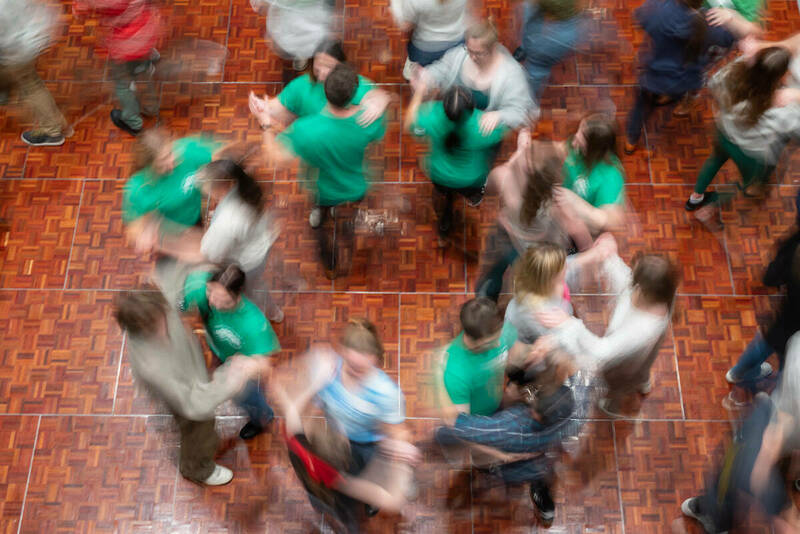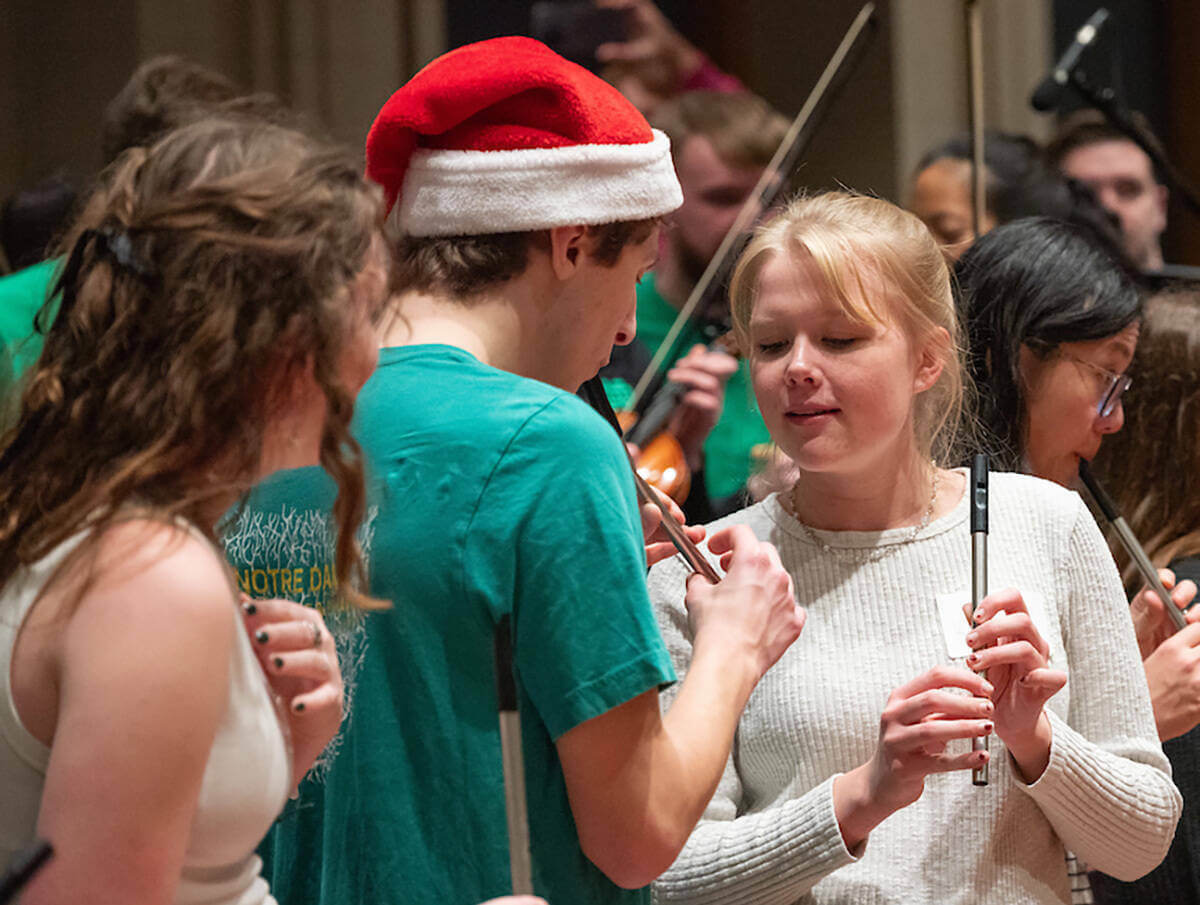 Photography by Mary Kate McGuirk ’24
Photography by Mary Kate McGuirk ’24

“If you need a partner, stick a hand up,” Shannon Dunne ’98 announced to the crowd gathering on the dance floor. It was an early-December night at Notre Dame, and students, faculty, family, and friends listened as Dunne kicked off a night of music and dance in the Irish céilí.
Céilís — defined as social gatherings with traditional Irish dance and music — have been hosted a few times each year by Notre Dame’s Department of Irish Language and Literature since 2021. They showcase faculty and student performances of Irish dance, music and song, with the campus community invited to participate in the cultural celebration.
That evening, Dunne cradled her concertina in the middle of a small stage above the dance floor in Corbett Family Hall’s Downes Club. Joining her were 30 or so student and faculty céilí band musicians of varying ages and experience. She directed the crowd to form inner and outer circles with their partners in preparation to learn a social dance.
Some on the floor are her dance class students, but many aren’t involved in the courses and are unfamiliar with Irish dance. As friends or strangers paired up, one girl timidly put her hand in the air in search of a partner. Before long, someone welcomed her into the circle.
Dunne began calling out dance moves. Those who were familiar with Irish social dance led the way, and even the beginners quickly caught on to the variations of “heel, toe, heel,” and “hop-a-one-two-three.” As they ran through the combinations, more people from the sidelines joined, expanding the circles.
Piano, concertina, fiddles and flutes kicked off the first song — “Santa Claus is Comin’ to Town” — and the dance floor erupted in movement. After every few bars of music, the circles shifted one person over. People traded reserved looks at their new partners, but as the dance carried on, those shy expressions turned into enthusiastic greetings, high fives and farewell waves. It was nearing the end of the semester, and the following week’s finals were the only thing separating the student body from a much-needed holiday break. But that night, exhaustion and stress played second fiddle to laughter.
Sarah McKibben, professor of Irish literature and chair of the department, watched from the sidelines. She has been on faculty more than 20 years, and her goal when she became department chair in July 2021 was to bring more Irish music and dance to campus. After dealing with pandemic restrictions, students craved joy more than ever, McKibben says — and a good dose of Irish culture could provide it.
“I just thought, ‘Notre Dame students need this,’” she says.

Dunne was researching in Notre Dame’s collection of Irish music when she was introduced to McKibben by Irish-born Aedín Ní Bhróithe Clements. Clements — who recently retired — was honored during the December céilí for her 18 years as Notre Dame’s Irish studies librarian and curator.
Dunne grew up dancing ballet, tap and jazz, and playing the piano. On a trip to Ireland in her 20s, she was introduced to sean-nós dancing — a “battering style step dance from the West of Ireland,” she says, and one she now teaches at Notre Dame.
“I told this girl that I saw dancing: ‘That is what I want to do, how do I learn to do it? And she said, ‘You just have to find people who do it,’” Dunne recalls. She started participating in workshops and attending festivals, making friends with people who taught her more about traditional Irish dance.
McKibben asked Dunne if she would like to teach classes as an adjunct faculty member in fall 2021. She did, and the classes immediately became popular. The first two were tin whistle and a dance class. By spring 2022, the tin whistle class had increased enrollment from four in the fall to 33. Some in the 25-student dance class started asking for another, and some inquired about a céilí band class.
Students pursue Irish studies for a variety of reasons, McKibben says: to learn about their own Irish heritage; to discover more about Irish history and politics; to explore the language. Dance and music classes are a logical extension. “It’s nice for them to be able to add dimensionality and depth to their studies, not just literature or history and so on, but to explore music and dance,” she says.
The goal of the céilís has shifted over time for Dunne.
“In Ireland music and dancing is everywhere, but here, because we were learning in a classroom, I thought that it wasn’t going to translate in the same way,” Dunne says. “So I felt like, at first, the céilí was a way for the people in the class to see it in a cultural context that would make sense. But then the céilís were so popular — now their purpose is to be a way for the Notre Dame community to come together.”
Throughout the December céilí, there was a rotation of performances from the social dance class, sean-nós dance class, tin whistle class, traditional Irish singing and broader group social dances, accompanied by traditional Irish songs and Christmas tunes from the Irish céilí band.
Shauna Ní Dhochartaigh, a foreign language teaching assistant from Donegal, Ireland, works with Dunne and her classes. She attended the céilí and participated in some of the singing and dancing events. Ordinarily, she has severe stage fright, but seeing the students perform — especially those with no experience — helped her overcome it. “It’s a bit rich to tell people ‘Oh, you do it!,” Ní Dhochartaigh says with a laugh.
Sophomore Declan Lee, from outside Detroit, played tin whistle and banjo at the céilí. In the crowd was his mother, Heather ’92, grandfather Richard Meaney ’60 and aunt Katie Meaney ’93, who came for the night to watch Declan perform.
Patrick Marshall, a Knott Hall sophomore from Anchorage, Alaska, had no experience with dance before this semester. He found the sean-nós course through class search because he had a credit to fill, and knew right away that he wanted to take it. “It was difficult to understand the rhythm at first,” Marshall says. But his skills have “changed by a thousand times.” Marshall even performed a short solo during the sean-nós group’s céilí performance. He says he will definitely be taking other dance courses in the future.
Emma Ryan ’24, an off-campus senior from the St. Louis area, says these celebrations “really connect you to the Notre Dame ‘Irish thing,’” and to her own Irish ancestry.
Happiness from the céilí, Ryan says, lingers for “like three days afterward.”
Kate Ross, a senior American studies major and journalism minor, was this magazine’s summer intern.